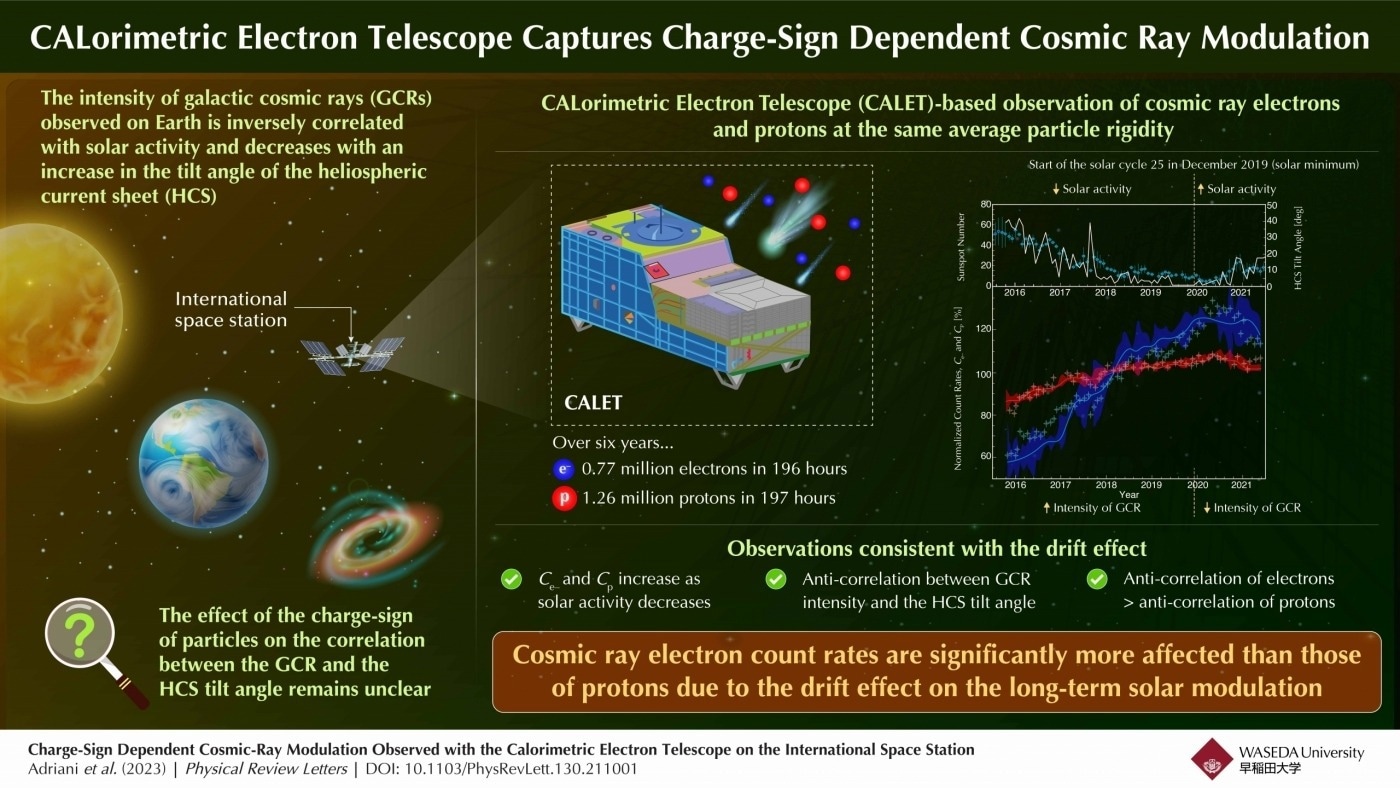Across space, the movement of cosmic ray particles like protons and electrons has been impacted by the magnetic field of the Sun. This leads to fluctuations in the intensity of galactic cosmic rays (GCRs), thereby reaching Earth in response to the solar cycle.

In a new study by the CALET collaboration, researchers from Japan demonstrate that cosmic ray electron count rates are significantly more affected than that of protons due to the drift effect on the long-term solar modulation. Image Credit: Yosui Akaike from Waseda University, Japan
At the time of low solar activity, like the solar minimum, a higher number of GCRs have been noted to reach Earth than for periods of high solar activity. This inverse correlation happening between the GCR-flux and solar activity is called “solar modulation.”
Particularly, the intensity of GCRs on Earth has been impacted by the tilt angle of the heliospheric current sheet (HCS), a spiral surface isolating the direction of oppositely directed magnetic field lines sourcing from the poles of the Sun.
Since there is an increase in the tilt angle of the HCS, there is a decrease in the intensity of cosmic rays on Earth. As per the drift model of GCR transport in the heliosphere, the negatively charged electrons present in GCRs tend to travel together with the HCS to reach Earth if the magnetic field has been directed away from the Sun in the northern hemisphere and also towards the Sun in the southern hemisphere.
On the contrary, the positively charged protons reach Earth from the heliospheric polar region, thereby showing that GCR electrons are highly impacted by solar modulation compared to the protons as they travel via the HCS to reach Earth.
While the earlier observations of cosmic ray particles that have been made aboard space balloons and in space experiments display variations between the fluxes of positively and negatively charged GCR particles during the solar cycle, it is not yet clear if the particle charge plays any role in the anticorrelation between GCR intensity and the HCS’ tilt angle.
Currently, in a recent observation of GCR-charged particles made with the CALorimetric Electron Telescope (CALET) aboard the International Space Station’s “Kibo” Exposed Facility (EF) over six years, scientists have disclosed that this anti-correlation is highly notable for electrons compared for protons.
The study, reported in Volume 130, Issue 21 of the Physical Review Letters journal on May 25th, 2023, was co-led by three scientists from Japan, Associate Professor Yosui Akaike of the Waseda Research Institute for Science and Engineering (RISE) at Waseda University, Associate Professor Shoko Miyake of the National Institute of Technology (KOSEN) at Ibaraki College, and Professor Kazuoki Munakata of Shinshu University.
Also, it added contributions from Professor Emeritus Shoji Torii from RISE.
Using CALET, we successfully observed a charge-sign dependent solar modulation of GCRs over six years.
Yosui Akaike, Associate Professor, Waseda Research Institute for Science and Engineering, Waseda University
More than 0.77 million electrons and 1.26 million protons gathered in nearly 196 and 197 hours were examined by the scientists, over a six-year period from 2015 to 2021, which corresponded with the end of solar cycle 24 and the start of solar cycle 25, the present solar cycle available.
The study outcomes showed that during the low activity state of the Sun towards the end of solar cycle 24, specified by a decrease in various sunspots and HCS tilt angle, both proton and electron count rates were low but slowly increasing.
This trend was retained with the start of solar cycle 25, thereby reaching its peak in electron count rate six months following the start of the cycle in December 2019.
From then on, both proton and electron count rates slowly got reduced as there was an increase in the Sun’s activity and HCS tilt angle. Moreover, the study outcomes showed that the change in the count rates of electrons was considerably greater compared to that of protons during this period. This shows electrons are highly susceptible to the impact of solar modulation, as anticipated by the drift model.
This is a clear signature of the drift effect dominating the long-term solar modulation of GCRs observed with a single detector.
Yosui Akaike, Associate Professor, Waseda Research Institute for Science and Engineering, Waseda University
On the whole, analyzing GCRs could have the potential to provide better insights into the light on the composition of the universe and the acceleration mechanisms of high-energy particles noted in cosmic rays.
Hence, the observations made by CALET could help better comprehend the space weather and its impacts on the likelihood of possible life on the Moon and other planets, like Mars.
Journal Reference
Adriani, O., et al. (2023) Charge-Sign Dependent Cosmic-Ray Modulation Observed with the Calorimetric Electron Telescope on the International Space Station. Physical Review Letters. doi.org/10.1103/PhysRevLett.130.211001.